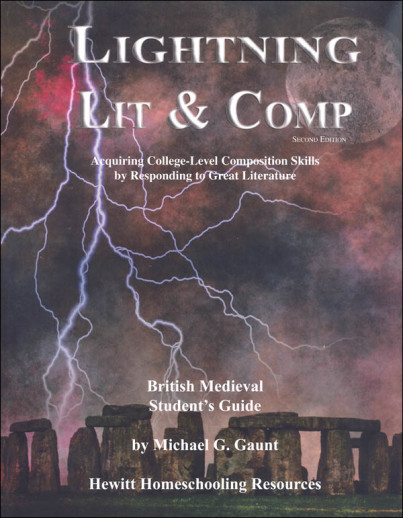We use cookies to make your experience better. To comply with the new e-Privacy directive, we need to ask for your consent to set the cookies. Learn more.
Lightning Literature & Composition British Medieval Literature Student Guide
Students read in the following order:
- Beowulf(epic poem; anonymous author)
- Anglo-Saxon riddles (text is in this Guide)
- Piers the Ploughman(epic poem; possibly by William Landland)
- York Mystery Play Cycle 42, The Ascension (play; anonymous author; text is in this Guide)
- Sir Gawain and the Green Knight(epic poem; anonymous author)
- Selection fromThe Gest of Robyn Hode(epic poem; anonymous author; (text is in this Guide)
- "St. Thomas Becket" fromThe Golden Legend(biography; anonymous author; (text is in this Guide)
- Selections fromThe Canterbury Tales(tales by Geoffrey Chaucer)
Lessons include story telling, imagery, symbolism, characterization, persuasive writing, drama, and description. For example,Beowulf is used to teach foreshadowing,Piers the Ploughmanteaches allegory, andSir Gawain and the Green Knightteaches tone. This course makes an excellent companion for studying Medieval History.
The Student's Guide includes comprehension questions, writing exercises, discussion questions, an additional reading list, semester and full-year schedules, and a bibliography. Answers to the comprehension questions are in the Teacher's Guide.
Recommendations: Generally speaking, this course is more difficult than all the other Lightning Literature courses except the Shakespeare courses. Much depends on student interest in the material, however. This course is especially recommended for students who have completed at least two previous high-school level Lightning Literature courses, who are studying medieval history, and who are interested in medieval literature. These should not be viewed as restrictions; this course can profitably be used by high-school students of any grade regardless of which previous Lightning Literature courses they have completed.
Covering literature by British authors from the medieval time period. Literature selections include: Beowulf - epic poem (anonymous author), Anglo-Saxon riddles, Piers the Ploughman - epic poem (possibly by William Landland), "York Mystery Play Cycle 42, The Ascension" - play (anonymous author), Sir Gawain and the Green Knight - epic poem (anonymous author), Selection from The Gest of Robyn Hode - epic poem (anonymous author), "St. Thomas Becket" from The Golden Legend - biography (anonymous author), andSelections from The Canterbury Tales (Geoffrey Chaucer).
Lessons include story telling, imagery, symbolism, characterization, persuasive writing, drama, and description. For example, Beowulf is used to teach foreshadowing, Piers the Ploughman teaches allegory, and Sir Gawain and the Green Knight teaches tone. This course makes an excellent companion for studying Medieval History. The Student Guide includes information about the authors, comprehension questions, writing exercises, discussion questions and project suggestions, reading lists appropriate to the period or subject, semester and full-year schedules, and a bibliography. The Teacher's Guide is needed if you want the answers to the comprehension questions. It also provides a teaching schedule, teaching and grading aids, and a copy of the writing exercises and discussion questions for the teacher's convenience.
This book is most useful for upper level students who have completed at least two previous high school level Lightning Literature courses and who are interested in medieval history and literature. It is more difficult than all the Lightning Literature courses except the Shakespeare courses. and who are studying modern history.
| Product Format: | Paperback |
|---|---|
| Grades: | 11-12 |
| Brand: | Hewitt Research Foundation |
| Author: | Michael G. Gaunt |
| ISBN: | 9781578962525 |
| Length in Inches: | 10.75 |
| Width in Inches: | 8.375 |
| Height in Inches: | 0.5 |
| Weight in Pounds: | 1.3 |

